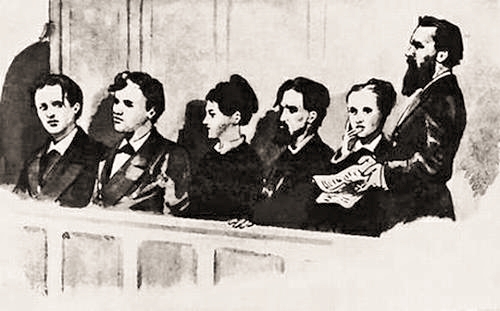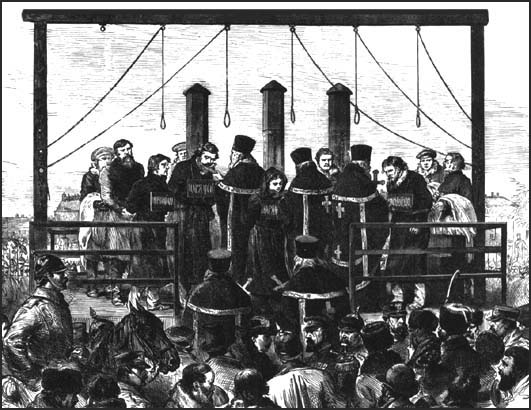|
Hesya Helfman
Hesya Mirovna (Meerovna) Helfman (, ) 1855, Mazyr — 1 ( N.S. 13) February 1882, Saint Petersburg), was a Russian revolutionary member of ''Narodnaya Volya'', who was implicated in the assassination of Tsar Alexander II. Biography Early life Born into a Jewish family, Helfman left home for Kiev at the age of 16 or 17, allegedly to avoid an arranged marriage, where she found employment in a sewing factory. Revolutionary activities In the early 1870s, Helfman was an active member of several revolutionary clubs in Kiev where she met, among others, Leo Deutsch and her future husband . Helfman was sentenced to two years' imprisonment at the during the 1877 , and on 14 March 1879 was sent into exile to the province Novgorod. She escaped a few months later and joined ''Narodnaya Volya'' in Saint Petersburg, probably following her husband who was a member of the organization's executive committee. In 1881 Helfman was part of the ''Narodnaya Volya'' group that assassinated Alexand ... [...More Info...] [...Related Items...] OR: [Wikipedia] [Google] [Baidu] |
Mazyr
Mazyr ( be, Мазыр, ; russian: Мозырь ''Mozyr'' , pl, Mozyrz , Yiddish: מאזיר) is a city in the Gomel Region of Belarus on the Pripyat River about east of Pinsk and northwest of Chernobyl. It is located at approximately . The population is 111,770 (2004 estimate). The total urban area, including the town of Kalinkavichy across the river, has a population of 150,000. Mazyr is known as a center of oil refining, salt extraction, machine building, and food processing in Belarus. It is home to one of the largest oil refineries in Belarus, pumping out 18 million metric tons per year, and is served by a tram line. The Druzhba pipeline carries crude oil from Russia, splitting in two at Mazyr. One pipeline branch is directed into Poland and the other one to Ukraine. Jewish community Jews were first mentioned in chronicles in the second half of the 17th century. It is known that there were three synagogues in the city as of 1856. R. Kugel, a prominent Jewish commu ... [...More Info...] [...Related Items...] OR: [Wikipedia] [Google] [Baidu] |
Arranged Marriage
Arranged marriage is a type of marital union where the bride and groom are primarily selected by individuals other than the couple themselves, particularly by family members such as the parents. In some cultures a professional matchmaker may be used to find a spouse for a young person. Arranged marriages have historically been prominent in many cultures. The practice remains common in many regions, notably South Asia, the Middle East, North Africa, and the Caucasus. In many other parts of the world, the practice has declined substantially during the 19th and 20th centuries. Forced marriages, practiced in some families, are condemned by the United Nations. The specific sub-category of forced child marriage is especially condemned. In other cultures, people mostly choose their own partner. History Arranged marriages were very common throughout the world until the 18th century. Typically, marriages were arranged by parents, grandparents or other close relatives and trusted friends ... [...More Info...] [...Related Items...] OR: [Wikipedia] [Google] [Baidu] |
Peter And Paul Fortress
The Peter and Paul Fortress is the original citadel of St. Petersburg, Russia, founded by Peter the Great in 1703 and built to Domenico Trezzini's designs from 1706 to 1740 as a star fortress. Between the first half of the 1700s and early 1920s it served as a prison for political criminals. It has been a museum since 1924. Today it has been adapted as the central and most important part of the State Museum of Saint Petersburg History. The museum has gradually become virtually the sole owner of the fortress building, except the structure occupied by the Saint Petersburg Mint (Monetniy Dvor). History From foundation until 1917 The fortress was established by Peter the Great on May 16 (Old Style; henceforth "(O.S.)"; May 27 by the Gregorian Calendar) 1703 on small Hare Island by the north bank of the Neva River, the last upstream island of the Neva delta. From around 1720, the fort served as a base for the city garrison and also as a prison for high-ranking or political priso ... [...More Info...] [...Related Items...] OR: [Wikipedia] [Google] [Baidu] |
Pregnancy
Pregnancy is the time during which one or more offspring develops ( gestates) inside a woman's uterus (womb). A multiple pregnancy involves more than one offspring, such as with twins. Pregnancy usually occurs by sexual intercourse, but can also occur through assisted reproductive technology procedures. A pregnancy may end in a live birth, a miscarriage, an induced abortion, or a stillbirth. Childbirth typically occurs around 40 weeks from the start of the last menstrual period (LMP), a span known as the gestational age. This is just over nine months. Counting by fertilization age, the length is about 38 weeks. Pregnancy is "the presence of an implanted human embryo or fetus in the uterus"; implantation occurs on average 8–9 days after fertilization. An ''embryo'' is the term for the developing offspring during the first seven weeks following implantation (i.e. ten weeks' gestational age), after which the term '' fetus'' is used until birth. Signs a ... [...More Info...] [...Related Items...] OR: [Wikipedia] [Google] [Baidu] |
Hanging
Hanging is the suspension of a person by a noose or ligature strangulation, ligature around the neck.Oxford English Dictionary, 2nd ed. Hanging as method of execution is unknown, as method of suicide from 1325. The ''Oxford English Dictionary'' states that hanging in this sense is "specifically to put to death by suspension by the neck", though it formerly also referred to crucifixion and death by impalement in which the body would remain "hanging". Hanging has been a common method of capital punishment since Middle Ages, medieval times, and is the primary execution method in numerous countries and regions. The first known account of execution by hanging was in Homer's ''Odyssey'' (Book XXII). In this specialised meaning of the common word ''hang'', the past and past participle is ''hanged'' instead of ''hung''. Hanging is a common method of suicide in which a person applies a ligature to the neck and brings about unconsciousness and then death by suspension or partial suspensi ... [...More Info...] [...Related Items...] OR: [Wikipedia] [Google] [Baidu] |
Trial (law)
In law, a trial is a coming together of parties to a dispute, to present information (in the form of evidence) in a tribunal, a formal setting with the authority to adjudicate claims or disputes. One form of tribunal is a court. The tribunal, which may occur before a judge, jury, or other designated trier of fact, aims to achieve a resolution to their dispute. Types by finder of fact Where the trial is held before a group of members of the community, it is called a jury trial. Where the trial is held solely before a judge, it is called a bench trial. Hearings before administrative bodies may have many of the features of a trial before a court, but are typically not referred to as trials. An appeal (appellate proceeding) is also generally not deemed a trial, because such proceedings are usually restricted to a review of the evidence presented before the trial court, and do not permit the introduction of new evidence. Types by dispute Trials can also be divided by t ... [...More Info...] [...Related Items...] OR: [Wikipedia] [Google] [Baidu] |
Pervomartovtsy
Pervomartovtsy (russian: Первома́ртовцы; a compound term literally meaning ''those of March 1'') were the Russian revolutionaries, members of ''Narodnaya Volya'', planners and executors of the assassination of Alexander II of Russia (March 1, 1881) and the attempted assassination of Alexander III of Russia (March 1, 1887, also known as "The Second First of March"). March 1, 1881 The assassination in 1881 was planned by Narodnaya Volya's Executive Committee. Andrei Zhelyabov was the main organizer. After his arrest on February 27, he was replaced by Sophia Perovskaya. Alexander II was killed on March 1, 1881 by a bomb, thrown by Ignacy Hryniewiecki. Hryniewiecki wounded himself fatally in the assassination; Nikolai Sablin committed suicide. Accomplices - Zhelyabov, Perovskaya, Nikolai Kibalchich, Hesya Helfman, Timofei Mikhailov, Nikolai Rysakov - were tried by the Special Tribunal of the Ruling Senate on March 26-29 and sentenced to deat ... [...More Info...] [...Related Items...] OR: [Wikipedia] [Google] [Baidu] |
Nikolai Sablin
Nikolai Alekseyevich Sablin (russian: Никола́й Алексе́евич Са́блин), was the son of a petty landowner, was born in 1849 or 1850 (sources vary). While at Moscow University he became involved in revolutionary politics as a member of the Narodnaya Volya or People's Will. Sablin went to Zurich in 1874 but returned to Russia the following year. He was arrested in March, 1875, but was not tried until January, 1878. He was found guilty but was soon released because of the long time he had been awaiting trial. A member of People's Will, Sabin joined the plot to kill Alexander II. Others involved included Sophia Perovskaya, Andrei Zhelyabov, Hesya Helfman, Ignaty Grinevitsky, Nikolai Kibalchich, Nikolai Rysakov, and Timofei Mikhailov. On 15 March 1881, two days after Alexander II was assassinated Assassination is the murder of a prominent or important person, such as a head of state, head of government, politician, world leader, member of a royal f ... [...More Info...] [...Related Items...] OR: [Wikipedia] [Google] [Baidu] |
Alexander II Of Russia
Alexander II ( rus, Алекса́ндр II Никола́евич, Aleksándr II Nikoláyevich, p=ɐlʲɪˈksandr ftɐˈroj nʲɪkɐˈlajɪvʲɪtɕ; 29 April 181813 March 1881) was Emperor of Russia, King of Poland and Grand Duke of Finland from 2 March 1855 until his assassination in 1881. Alexander's most significant reform as emperor was the emancipation of Russia's serfs in 1861, for which he is known as Alexander the Liberator ( rus, Алекса́ндр Освободи́тель, r=Aleksándr Osvobodytel, p=ɐlʲɪˈksandr ɐsvəbɐˈdʲitʲɪlʲ). The tsar was responsible for other reforms, including reorganizing the judicial system, setting up elected local judges, abolishing corporal punishment, promoting local self-government through the '' zemstvo'' system, imposing universal military service, ending some privileges of the nobility, and promoting university education. After an assassination attempt in 1866, Alexander adopted a somewhat more conservative s ... [...More Info...] [...Related Items...] OR: [Wikipedia] [Google] [Baidu] |
Narodnaya Volya (organization)
Narodnaya Volya ( rus, Наро́дная во́ля, p=nɐˈrodnəjə ˈvolʲə, t=People's Will) was a late 19th-century revolutionary political organization in the Russian Empire which conducted assassinations of government officials in an attempt to overthrow the autocratic system and stop the government reforms of Alexander II of Russia. The organization declared itself to be a populist movement that succeeded the Narodniks. Composed primarily of young revolutionary socialist intellectuals believing in the efficacy of terrorism, ''Narodnaya Volya'' emerged in Autumn 1879 from the split of an earlier revolutionary organization called ''Zemlya i Volya'' ("Land and Liberty"). Based upon an underground apparatus of local, semi-independent cells co-ordinated by a self-selecting Executive Committee, ''Narodnaya Volya'' continued to espouse acts of revolutionary violence in an attempt to spur mass revolt against Tsarism, culminating in the successful assassination of Tsar Alexand ... [...More Info...] [...Related Items...] OR: [Wikipedia] [Google] [Baidu] |





.jpg)
